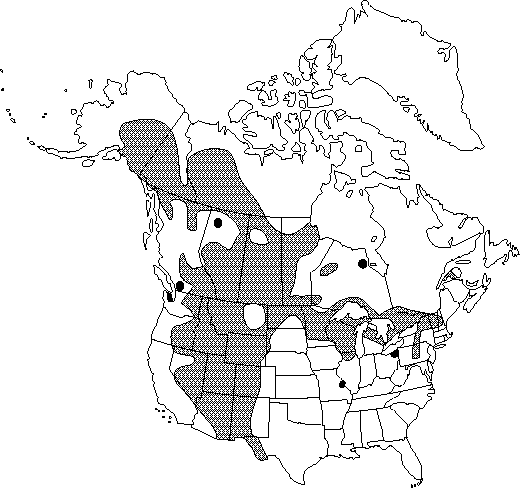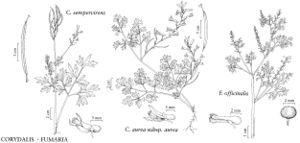Difference between revisions of "Corydalis aurea subsp. aurea"
Selected by author to be illustrated
Treatment appears in FNA Volume 3.
FNA>Volume Importer |
FNA>Volume Importer |
||
| Line 23: | Line 23: | ||
|elevation=100-3400 m | |elevation=100-3400 m | ||
|distribution=Alta.;B.C.;Man.;N.W.T.;Ont.;Que.;Sask.;Yukon;Alaska;Ariz.;Calif.;Colo.;Idaho;Ill.;Mich.;Minn.;Mo.;Mont.;Nebr.;Nev.;N.H.;N.Mex.;N.Y.;N.Dak.;Ohio;Oreg.;Pa.;S.Dak.;Tex.;Utah;Vt.;Wash.;Wis.;Wyo.;n Mexico. | |distribution=Alta.;B.C.;Man.;N.W.T.;Ont.;Que.;Sask.;Yukon;Alaska;Ariz.;Calif.;Colo.;Idaho;Ill.;Mich.;Minn.;Mo.;Mont.;Nebr.;Nev.;N.H.;N.Mex.;N.Y.;N.Dak.;Ohio;Oreg.;Pa.;S.Dak.;Tex.;Utah;Vt.;Wash.;Wis.;Wyo.;n Mexico. | ||
| − | |discussion=<p>Corydalis aurea subsp. aurea intergrades at times with C. aurea subsp. occidentalis, but usually the two can be distinguished readily when fruiting.</p> | + | |discussion=<p><i>Corydalis aurea </i>subsp.<i> aurea</i> intergrades at times with <i>C. aurea </i>subsp.<i> occidentalis</i>, but usually the two can be distinguished readily when fruiting.</p> |
|tables= | |tables= | ||
|references= | |references= | ||
| Line 47: | Line 47: | ||
|publication year= | |publication year= | ||
|special status=Selected by author to be illustrated | |special status=Selected by author to be illustrated | ||
| − | |source xml=https://jpend@bitbucket.org/aafc-mbb/fna-data-curation.git/src/ | + | |source xml=https://jpend@bitbucket.org/aafc-mbb/fna-data-curation.git/src/8f726806613d60c220dc4493de13607dd3150896/coarse_grained_fna_xml/V3/V3_398.xml |
|genus=Corydalis | |genus=Corydalis | ||
|species=Corydalis aurea | |species=Corydalis aurea | ||
Revision as of 17:16, 18 September 2019
Inflorescences: racemes weak, generally exceeded by leaves. Flowers: petals sometimes crested. Capsules pendent or spreading at maturity, slender, 18-24(-30)mm. Seeds without marginal ring. 2n = 16.
Phenology: Flowering spring–late summer.
Habitat: Talus slopes, ledges, rocky hillsides, forest clearings, open shores, creek bottoms, gravel pits, road cuts, and burned-over areas, in loose, often gravelly soil
Elevation: 100-3400 m
Distribution

Alta., B.C., Man., N.W.T., Ont., Que., Sask., Yukon, Alaska, Ariz., Calif., Colo., Idaho, Ill., Mich., Minn., Mo., Mont., Nebr., Nev., N.H., N.Mex., N.Y., N.Dak., Ohio, Oreg., Pa., S.Dak., Tex., Utah, Vt., Wash., Wis., Wyo., n Mexico.
Discussion
Corydalis aurea subsp. aurea intergrades at times with C. aurea subsp. occidentalis, but usually the two can be distinguished readily when fruiting.
Selected References
None.
Lower Taxa
None.
... more about "Corydalis aurea subsp. aurea"
Alta. +, B.C. +, Man. +, N.W.T. +, Ont. +, Que. +, Sask. +, Yukon +, Alaska +, Ariz. +, Calif. +, Colo. +, Idaho +, Ill. +, Mich. +, Minn. +, Mo. +, Mont. +, Nebr. +, Nev. +, N.H. +, N.Mex. +, N.Y. +, N.Dak. +, Ohio +, Oreg. +, Pa. +, S.Dak. +, Tex. +, Utah +, Vt. +, Wash. +, Wis. +, Wyo. + and n Mexico. +
Talus slopes, ledges, rocky hillsides, forest clearings, open shores, creek bottoms, gravel pits, road cuts, and burned-over areas, in loose, often gravelly soil +
Present +
Enum. Pl. +
1809 +
Selected by author to be illustrated +
Corydalis aurea subsp. aurea +
Corydalis aurea +
subspecies +
